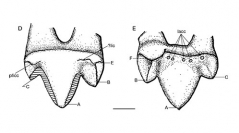

 Geodiversitas
24 (2) - Pages 445-464
Geodiversitas
24 (2) - Pages 445-464New mammalian teeth recovered from the Lower/Middle Jurassic Kota Formation, Pranhita-Godavari valley, peninsular India, are described. In its gross morphology, VPL/JU/KM/13 compares well with Dyskritodon amazighi Sigogneau-Russell, 1995, an Early Cretaceous triconodont from Morocco. Based on size and some morphological differences, this tooth is referred to a new species Dyskritodon indicus n. sp. Another fragmentary tooth (VPL/JU/KM/14) is assigned to Triconodonta indet. with possible affinities to morganucodontids. Re-examination and comparison of Kotatherium yadagirii Prasad & Manhas, 1997, previously documented from the same formation, with various Mesozoic mammalian groups reveal that K. yadagirii is not a symmetrodont, more likely a triconodont (family Morganucodontidae). Therefore, a new genus Paikasigudodon n. gen. is established for this taxon. Indotherium pranhitai Yadagiri, 1984 is retained in the family Morganucodontidae, but the type tooth as well as the attributed tooth (VPL/JU/KM/11) are now considered as upper molars.
Mammalia, triconodonts, Jurassic, Kota Formation, India, new genus, new species